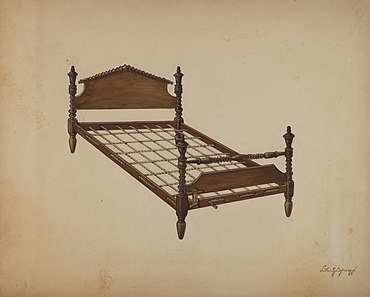Rope bed

Medieval-reconstruction rope beds (circa 1465); note loops of rope protruding from side boards

A rope bed without its mattresses etc.
A rope bed is a type of platform bed in which the sleeper (and mattress) is supported by a lattice of rope, rather than wooden slats.
In cold climates, a rope bed would be topped with an insulating palliasse or tick, which would traditionally be stuffed with straw, chaff, or down feathers. It might also have a canopy hung with warm curtains.[1][2] Modernly, they may be topped by a thin futon or other roll-up mattress.[3]
Rope beds need to be tightened regularly (with a bed wrench, and sometimes with wedges) as they sag. They must also be re-strung occasionally; re-stringing reduces sag and evens out wear.[4][3][5] When fully or partly unstrung, rope beds can be packed flat for transport.[3]
See also[]
| Wikimedia Commons has media related to Rope bedframes. |
- Charpai (warm-climate version)
- Platform bed
References[]
- ^ Karstensen, Rebecca (2018-01-18). Graves, Jean (ed.). "Sleep Tight, Don't Let the Bed Bugs Bite – A Myth Debunked". libraries.indiana.edu.
- ^ "Canopy beds and rope beds". Greydragon Furniture collection.
- ^ a b c Devin, Harold. "Making a Rope Bed" (PDF).
- ^ Wright, Bryan. "Colonial Sense: How-To Guides: Interior: Bed Roping". Colonial Sense.
- ^ "The Stamford Historical Society, A virtual tour through the Hoyt-Barnum House". www.stamfordhistory.org.
Categories:
- Furniture stubs
- Beds
- Portable furniture